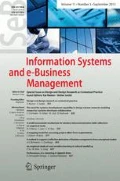Abstract
An important decision support system component is machine learning/data mining. Classical machine learning methods implicitly assume that attributes of instances under classification do not change to acquire a positive classification. However, in many situations these instances represent people or organizations that can proactively seek to alter their characteristics to gain a positive classification. We argue that the learning mechanism should take this possible strategic learning into consideration during the induction process. We call this strategic learning. In this paper we define this concept, summarize related research, and present a number of future research areas.


Similar content being viewed by others
References
Abdel-Khalik AR, El-Sheshai KM (1980) Information choice and utilization in an experiment on default prediction. J Account Res 18(2):325–342
Agrawal R, Imielinski T, Swami A (1993) Mining association rules between sets of items in large databases. In: Proceedings of the ACM SIGMOD conference on management of data, pp 207–216
Arnt A, Zilberstein S (2005) Learning policies for sequential time and cost sensitive classification. In: Proceedings of the KDD-05 workshop on utility-based data mining, pp 39–46
Aytug H, Boylu F, Koehler GJ (2006) Learning in the presence of self-interested agents. In: Proceedings of the 39th annual hawaii international conference on system sciences (HICSS’06), vol 7, p 158b
Bhattacharyya S, Tharakunnel KK (2005) Reinforcement learning in leader–follower multi-agent systems: framework and an algorithm, information and decision sciences. University of Illinois, Chicago
Bishop C (1995) Neural networks for pattern recognition. Oxford University Press, New York
Boylu F, Aytug H, Koehler GJ (2005) Discrimination with strategic behavior. In: Decision and information sciences. University of Florida, Gainesville
Boylu F, Aytug H, Koehler GJ (2006) Strategic learning with constrained agents. In: Decision and information sciences. University of Florida, Gainesville
Ciraco M, Rogalewski M, Weiss G (2005) Improving classifier utility by altering the misclassification cost ratio. In: Proceedings of the KDD-05 workshop on utility-based data mining, pp 46–53
Cristianini N, Shawe-Taylor J (2000) An introduction to support vector machines and other kernel-based methods. Cambridge University Press, Cambridge
Crone S, Lessmann S, Stahlblock R (2005) Utility based data mining for time series analysis: cost sensitive learning for neural network predictors. In: Proceedings of the KDD-05 workshop on utility-based data mining, pp 59–69
Dalvi N, Domingos P, Mausam S, Sanghai, Verma D (2004) Adversarial classification. In: Tenth ACM SIGKDD international conference on knowledge discovery and data mining (KDD), pp 99–108
Ehtamo H, Kitti M, Hämäläinen PR (2002) Recent studies on incentive design problems in game theory and management science. In: Optimal control and differential games, essays in honor of Steffen Jørgensen, pp 121–134
Elkan C (2001) The foundations of cost-sensitive learning. In: Proceedings of the seventeenth international joint conference on artificial intelligence (IJCAI’01), pp 973–978
Fan M, Stallaert J, Whinston AB (2003) Decentralized mechanism design for supply chain organizations using auction market. Inf Syst Res 14(1):1–22
Fisher RA (1936) The use of multiple measurements in taxonomic problems. Ann Eugen 7:179–188
Holte R, Drummond C (2005) Cost-sensitive classifier evaluation. In: Proceedings of the KDD-05 workshop on utility-based data mining, p 3
Kaelbling LP, Littman ML, Moore AW (1996) Reinforcement learning: a survey. J Artif Intell Res 4:1039–1069
Kapoor A, Greiner R (2005) Reinforcement learning for active model selection. In: Proceedings of the KDD-05 workshop on utility-based data mining, pp 17–24
Keyhani A (2003) Leader–follower framework for control of energy services. IEEE T Power Syst 18(2):837–841
Laffont JJ, Martimort D (2002) The theory of incentives: the principal–agent model. Princeton University Press, Princeton
Littman ML (1994) Markov games as a framework for multi-agent reinforcement learning. In: Proceedings of the eleventh international conference on machine learning, pp 157–163
McCarthy K, Zabar B, Weiss G (2005) Does cost-sensitive learning beat sampling for classifying rare classes? In: Proceedings of the KDD-05 workshop on utility-based data mining, pp 69–78
Melville P, Saar-Tsechansky M, Provost F, Mooney R (2005) Economical active feature-value acquisition through expected utility estimation. In: Proceedings of the KDD-05 workshop on utility-based data mining, pp 10–17
Morrison C, Cohen P (2005) Noisy information value in utility-based decision making. In: Proceedings of the KDD-05 workshop on utility-based data mining, pp 34–39
Provost FJ (2005) Toward economic machine learning and utility-based data mining. In: Proceedings of the KDD-05 workshop on utility-based data mining, p 1
Quinlan JR (1986) Induction of decision trees. Mach Learn 1:81–106
Samuel AL (1959) Some studies in machine learning using the game of checkers. IBM J Res Dev 49:210–229
Sutton RS, Barto AG (1998) Reinforcement learning: an introduction. MIT Press, Cambridge
Vapnik V (1998) Statistical learning theory. Wiley, New York
Weiss G, Provost F (2003) Learning when training data are costly: the effect of class distribution on tree induction. J Artif Intell Res 19:315–354
Zadrozny B (2005) One-benefit learning: cost-sensitive learning with restricted cost information. In: Proceedings of the KDD-05 workshop on utility-based data mining, pp 53–59
Author information
Authors and Affiliations
Corresponding author
Additional information
This article is part of the “Handbook on Decision Support Systems” edited by Frada Burstein and Clyde W. Holsapple (2008) Springer.
Rights and permissions
About this article
Cite this article
Boylu, F., Aytug, H. & Koehler, G.J. Systems for strategic learning. ISeB 6, 205–220 (2008). https://doi.org/10.1007/s10257-007-0065-x
Published:
Issue Date:
DOI: https://doi.org/10.1007/s10257-007-0065-x




